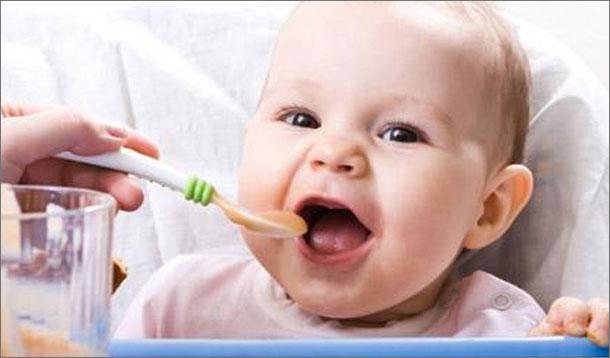
Your doctor is the best person to advise you as to when your baby should start eating solid food, but this generally happens at around the six-month mark.1 At this time, babies generally have the coordination needed to move food from the front of their mouth to the back in order to swallow.2 They are typically able to sit up and support their neck and head at this age, prerequisites for transitioning from a liquid diet. Your baby will also let you know when he is ready. He will show interest in your food and may even try to grab at it if it is within reach. When all of these factors combine, your baby is ready for solid food to complement his diet of breast milk or formula.
Baby cereal - Most babies start off with a small amount of iron-fortified infant rice cereal.3 It should be mixed with breast milk or formula so that it is more liquid than solid at first, until your baby gets the hang of swallowing from the spoon. Increase the ratio of cereal to liquid as your baby progresses.
Puréed foods - When your baby is managing the cereal well, you can introduce puréed vegetables, fruit and meat. Start with a mild-tasting vegetable, and ones like carrots, squash and sweet-potatoes (which are generally least allergenic4), gradually moving to fruit and then to proteins like meat as your baby develops. Experts recommend that you feed only single-ingredient food at first, e.g. carrots as opposed to carrots mixed with chicken or corn. Wait at least four days before offering another single-ingredient food. This makes it easier to detect food allergies if your baby has a reaction, such as diarrhea or a rash.5
Babies have a sweet tooth and will generally gravitate towards puréed fruits like applesauce or puréed vegetables like sweet potato but it is important to offer other foods as well. If your baby refuses, then try again at another meal, and try again after that. A variety of foods encourages good eating habits later.
Soft foods - By eight to ten months, your baby can graduate to small portions of unpuréed food, such as well-cooked pasta or small pieces of soft fruit. Your baby’s diet will begin to resemble that of the rest of the family by the twelve-month mark, although his will be a mashed or chopped version, supplemented by breast milk or formula.
Juice - This can be given after six months of age, although it should be in quantities of no more than 120 mL per day.6 Too much juice can cause diarrhea. It can also fill baby up and add calories to his diet, without providing the nutritional benefit needed. Only 100% fruit juice should be served.
![]() Choking hazards. Whole grapes could get lodged in a baby’s throat, as could bite-sized pieces of hot dog.
Choking hazards. Whole grapes could get lodged in a baby’s throat, as could bite-sized pieces of hot dog.
![]() Citrus fruits and juices. The high acidity can contribute to painful diaper rashes.
Citrus fruits and juices. The high acidity can contribute to painful diaper rashes.
![]() Cow’s milk. It doesn’t meet your baby’s nutritional needs during his first year, and can lead to iron deficiency anemia.
Cow’s milk. It doesn’t meet your baby’s nutritional needs during his first year, and can lead to iron deficiency anemia.
![]() Hard-to-chew foods. For example, popcorn or nuts.
Hard-to-chew foods. For example, popcorn or nuts.
![]() Honey or corn syrup. They may contain spores that, although harmless to older children and adults, can cause serious illness in babies due to infant botulism.
Honey or corn syrup. They may contain spores that, although harmless to older children and adults, can cause serious illness in babies due to infant botulism.
Speak to your health care provider to get information on other foods that should be avoided, particularly if food allergies run in the family.
Signs of Allergy - Your baby may be bloated or more gassy than usual, which can cause sleep disruptions or general fussiness. He may have diarrhea or a rash, or vomit after eating certain foods. Speak to your doctor about the foods that have caused this. If your baby has breathing difficulties or hives, get immediate medical attention.
Solids – even if they seem more liquid than solid, like the cereal in breast milk or formula that your baby will start with – should always be served from a spoon. Support your baby on your lap or seat him in an upright baby seat or a high chair, using the safety straps. Put the spoon against your baby’s lips, encouraging him to smell and taste. He may respond eagerly or turn away from the offered food and either reaction is fine. This is baby’s first introduction to ‘solids’ and it may take a few attempts. If your baby refuses the food, don’t force him, but try again later. As long as baby is still getting sufficient breast milk or formula, he is fine, but speak to your doctor about any concerns you may have.
Babies are messy eaters, even when you are guiding the food into their mouth. The food may end up on your baby’s chin, bib, the high-chair tray or the floor and this is to be expected. Spread a sheet under your baby’s feeding station to make clean-up easier.
This is an exciting – and messy – time for you and your baby. It’s an important milestone in your baby’s development, and the start of lifelong healthy eating habits. Enjoy every moment!